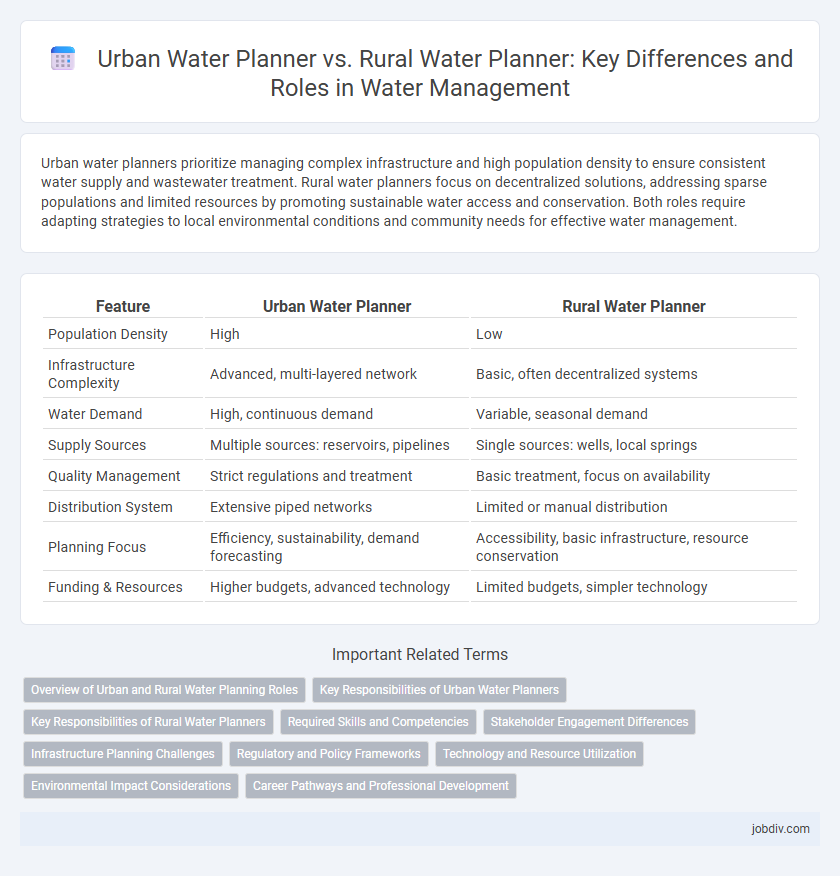Urban water planners prioritize managing complex infrastructure and high population density to ensure consistent water supply and wastewater treatment. Rural water planners focus on decentralized solutions, addressing sparse populations and limited resources by promoting sustainable water access and conservation. Both roles require adapting strategies to local environmental conditions and community needs for effective water management.
Table of Comparison
| Feature | Urban Water Planner | Rural Water Planner |
|---|---|---|
| Population Density | High | Low |
| Infrastructure Complexity | Advanced, multi-layered network | Basic, often decentralized systems |
| Water Demand | High, continuous demand | Variable, seasonal demand |
| Supply Sources | Multiple sources: reservoirs, pipelines | Single sources: wells, local springs |
| Quality Management | Strict regulations and treatment | Basic treatment, focus on availability |
| Distribution System | Extensive piped networks | Limited or manual distribution |
| Planning Focus | Efficiency, sustainability, demand forecasting | Accessibility, basic infrastructure, resource conservation |
| Funding & Resources | Higher budgets, advanced technology | Limited budgets, simpler technology |
Overview of Urban and Rural Water Planning Roles
Urban Water Planners design complex water distribution systems catering to dense populations, emphasizing infrastructure resilience, water quality, and sustainable resource management. Rural Water Planners focus on decentralized systems, addressing limited access, groundwater management, and agricultural water needs to support dispersed communities. Both roles require integrating environmental regulations with local socio-economic factors to ensure reliable water supply and sanitation.
Key Responsibilities of Urban Water Planners
Urban Water Planners focus on designing and managing complex water distribution systems to support high population densities, ensuring efficient supply and wastewater treatment in cities. They integrate advanced technologies such as smart water meters and real-time monitoring to optimize resource allocation and reduce water loss. Their responsibilities also include stormwater management, flood control, and maintaining water quality standards to protect urban public health and infrastructure.
Key Responsibilities of Rural Water Planners
Rural Water Planners focus on designing and managing water supply systems that address the unique challenges of dispersed populations and limited infrastructure in rural areas. They prioritize sustainable water use, infrastructure development, and ensuring access to clean, safe drinking water while considering local environmental impacts and community needs. Key responsibilities include coordinating with local governments, conducting water quality assessments, and implementing conservation strategies tailored to rural settings.
Required Skills and Competencies
Urban Water Planners require expertise in managing complex infrastructure, advanced hydrological modeling, and knowledge of regulatory frameworks due to high population density and diverse water demands. Rural Water Planners must possess strong skills in community engagement, resource sustainability, and adaptive management to address limited infrastructure and variable water availability. Both roles demand proficiency in geographic information systems (GIS), water quality assessment, and environmental impact analysis tailored to their distinct contexts.
Stakeholder Engagement Differences
Urban water planners typically engage a diverse range of stakeholders including municipal governments, commercial enterprises, and dense residential communities, necessitating complex coordination and frequent public consultations. Rural water planners often interact more closely with agricultural users, small municipalities, and local indigenous groups, emphasizing trust-building and hands-on collaboration to address limited infrastructure and resource constraints. These differing contexts demand tailored engagement strategies to effectively manage water distribution, quality, and sustainability challenges unique to urban and rural environments.
Infrastructure Planning Challenges
Urban water planners confront complex infrastructure challenges including high population density, aging pipe networks, and the need for advanced stormwater management systems. Rural water planners face difficulties related to dispersed populations, limited funding, and maintaining reliable access to groundwater sources. Both require tailored approaches to ensure sustainable water supply and efficient distribution in their respective environments.
Regulatory and Policy Frameworks
Urban water planners navigate complex regulatory frameworks involving municipal water quality standards, infrastructure compliance, and urban growth policies, emphasizing integrated water resource management. Rural water planners often operate within less stringent but diverse policy environments focused on decentralized water systems, agricultural water rights, and conservation initiatives. Both planners must align with national water laws and local ordinances while addressing unique community water needs and sustainability goals.
Technology and Resource Utilization
Urban water planners leverage advanced technologies such as smart sensors, real-time data analytics, and automated water distribution systems to optimize resource utilization in densely populated areas. Rural water planners prioritize cost-effective, scalable solutions like solar-powered pumps, rainwater harvesting, and decentralized treatment facilities to address limited infrastructure and variable water availability. Efficient resource management in both contexts depends on integrating technology tailored to demographic needs and environmental conditions.
Environmental Impact Considerations
Urban water planners prioritize managing stormwater runoff and reducing pollution from dense infrastructure to minimize environmental degradation in cities. Rural water planners focus on sustainable groundwater use and protecting natural water sources from agricultural runoff to preserve ecosystem health. Both roles require tailored strategies to balance human needs with long-term environmental impact mitigation.
Career Pathways and Professional Development
Urban Water Planners typically advance through careers involving complex infrastructure projects, water resource management, and policy development tailored for densely populated areas, requiring expertise in advanced hydrological modeling and regulatory frameworks. Rural Water Planners focus on sustainable water supply systems, agricultural irrigation strategies, and community engagement, often gaining proficiency in decentralized water treatment technologies and environmental conservation practices. Professional development for both pathways emphasizes certifications in water resource management, GIS applications, and continuous education on climate resilience and sustainable water policies.
Urban Water Planner vs Rural Water Planner Infographic

 jobdiv.com
jobdiv.com